#Bay Area tourism
Text
8 ways to explore the Bay Area without breaking the bank
The Bay Area is one of the most iconic and culturally rich regions in the United States, with a unique blend of natural beauty, diversity, and history. From the stunning vistas of the Golden Gate Bridge to the vibrant cultural scene of San Francisco, there are countless reasons to explore this dynamic region.
Exploring the Bay Area can be a dream come true for many, but it can also be expensive.…
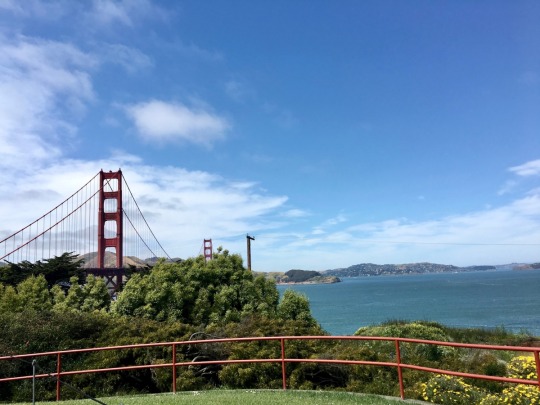
View On WordPress
#Bay Area landmarks#Bay Area on a budget#Bay Area tourism#budget travel#budget-friendly travel#Coit Tower#cultural scene#exploring the Bay Area#Golden Gate Bridge#innovation hub#Lombard Street#outdoor activities#Point Bonita#San Francisco attractions#San Francisco Bay#Silicon Valley tourism#tech industry#tourist destinations#travel guide
0 notes
Text
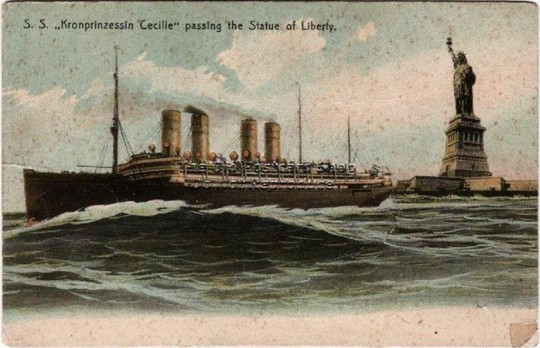

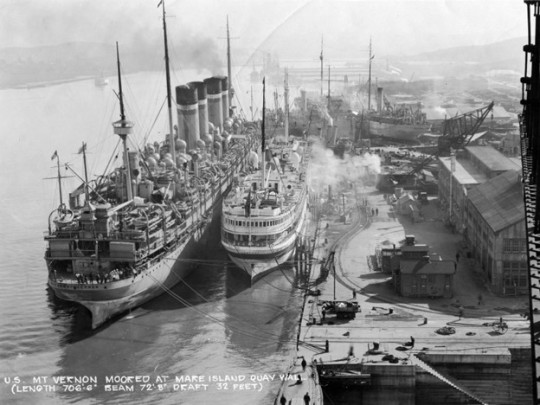
Rules are Rules
The US Army transport ship USS Mount Vernon (ID-4508) was originally the huge German passenger liner S.S. Kronprinzesin Cecilie, built in Stettin, Germany, in 1906. As a US Army ship she had an eventful history including a humorous event at Mare Island Naval Shipyard.
When World War I broke out in 1914 the S.S. Kronprinzesin Cecilie and 113 Austrian and German merchant vessels sought shelter in US Ports from the English and French fleets who would have hunted them down and sunk them. Those ships sat unused until the US entered the war in 1917 at which time they were all seized in a coordinated action. Aware of the pending seizure, all the ships were sabotaged by their crews on orders from the German High Command to prevent their use against Germany. It did not work, even though the S.S. Kronprinzesin Cecilie’s huge cast cylinders for her steam engines were smashed, US naval personnel pioneered a process to weld repair the castings returning her and others like her to service much quicker than the German’s anticipated. Together with other US flag ships, they carried two million American servicemen to France leading to the defeat of the Germans by Allied Forces.
The Mount Vernon made the first of nine trips across the Atlantic, hauling troops to and from the battlefields in October of 1917. Then one year later Mount Vernon was headed for the US with a load of wounded soldiers. 200 miles off the French port of Brest gun crews sighted a submarine periscope. It was too late to take evasive action as a torpedo slammed into her side and water began rushing in. The captain reversed course and personnel manned lifeboats to abandon ship if necessary as he steamed back towards Brest with damage control parties fighting the flooding. She made it to safety and was quickly repaired and put back in service. Then in 1919 with war over she was sent out to the Pacific.
On 17 October 1919 Mount Vernon was transferred to operation by the Army Transport Service where the ship was assigned to the Army's Pacific fleet based at Fort Mason in San Francisco. She steamed through the Panama Canal and into San Francisco Bay on Monday, November 10, 1919. At 706 ft long and 32,000 tons displacement she was the largest ship ever to transit the canal or sail into San Francisco Bay. Her mission was to sail to Vladivostok, Russia to return US troops and repatriate German prisoners of war and Czechoslovak troops who had been fighting the Russian Bolsheviks. But before she headed to Russia, she went to Mare Island for repairs. The process for ships heading to the shipyard was for the Mare Island Pilot to board the ship out in the Carquinez Straits and guide it to the pier through the narrow channel in the Mare Island Straits. No doubt the pilot was looking forward to the opportunity to guide this massive ship up the waterway. People would talk about it for years, and they did, but probably not for the reasons he supposed.
When the massive ship arrived off the Mare Island Straits her Army Captain did not pause as expected and, instead, he proceeded up the Strait to a position opposite the shipyard. Alarmed by the sudden appearance of the huge ship, Mare Island officials radioed her advising the captain that he was not authorized to proceed up the channel without the Mare Island pilot on board. In response, the Army Captain swung the giant ship around and sailed back down the channel to await the pilot out in the Carquinez Straits. Once the Mare Island pilot was on the bridge of the Mount Vernon, she then proceeded yet again up the straits to the shipyard. Fortunately for the pilot, the trip was as uneventful as the first or he never would have heard the end of it (he probably never did anyway).
#mare island#naval history#san francisco bay#us navy#vallejo#world war 1#world war i#world war one#bay area#California#northbay#solano#sonoma#napa#wine country#military#tourism
0 notes
Text
The great fault of the global left is not that it supports Hamas. For how could Western left-wing movements or left-inclining charities or academic bodies truly support Hamas if they were serious about their politics?
No one outside the most reactionary quarters of Islam shares Hamas’s aim of forcing the peoples of the world to accept “the sovereignty of Islam” or face “carnage, displacement and terror” if they refuse. You cannot be a progressive and campaign for a state that executes gay men. An American left, which includes in its ranks the Queers for Palestine campaign group, cannot seriously endorse lethal homophobia in its own country. They will turn a blind eye in Palestine, as we shall see, but not in New York or Chicago.
Finally, no left organisation proudly honours the Protocols of the Elders of Zion and the fascist tradition that Hamas embraces with such sinister gusto, although in a sign of a decay that has been building on the left for more than a generation, many will promulgate left-wing conspiracy theories which are as insane as their fascist counterparts.
No, the problem with the global left is that it is not serious about politics. It “fellow travels” with radical Islam rather than supports it. The concept of “fellow travelling,” with its suggestions of tourism, dilettantism, and privilege, is well worth reviving. The phrase comes from the Bolsheviks. After the Russian Revolution of 1917 they looked with appreciation on Westerners who supported them without ever endorsing communism. Artists, writers, and academics who were disgusted with the West, often for good reason, I should add, were quite happy to justify Soviet communism and cover up its crimes without ever becoming communists themselves.
Leon Trotsky put it best when he said of fellow travellers that the question was always “how far would they go”? As long as they did not have live under the control of communists in the 1920s or the control of Islamists in the 2020s, the answer appears to be: a very long way indeed
W.H. Auden said, as he looked back with some contempt on his fellow travelling past, if Britain or the United States or any country he and his friends knew were taken over by a “successful communist revolution with the same phenomena of terror, purges, censorship etc., we would have screamed our heads off”. But as communism happened in backward Russia “a semi-barbarous country which had experienced neither the Renaissance nor the Enlightenment”, they could ignore its crimes in the interests of seeing the capitalist enemy defeated.
You see the same pattern of lies and indulgence in the case of Hamas. Journalists have produced a multitude of examples of fellow travelling since 7 October but let one meeting of the Oakland City Council in the Bay area of San Francisco speak for them all.
A council member wanted the council to pass a motion that condemned the killings and hostage-taking by Hamas, who, in case we forget, prompted the war that has devastated Gaza, by massacring Israeli civilians. The motion got nowhere
According to one speaker Hamas did not massacre anyone, a modern variant of Holocaust denial that is becoming endemic. “There have not been beheadings of babies and rapings,” a woman said at the meeting. “Israel murdered their own people on October 7.” Another woman said that calling Hamas a terrorist organization is “ridiculous, racist and plays into the genocidal propaganda that is flooding our media.” Hamas was the “armed wing of the unified Palestinian resistance” , said a third who clearly had no knowledge of the civil war between Hamas and Fatah.
“To condemn Hamas was very anti-Arab racist” cried a fourth. The meeting returned to modern Holocaust denial as a new speaker said the Israeli Defence Forces had murdered their own people and it was “bald propaganda” to suggest otherwise. A man intervened to shout that “to hear them complain about Hamas violence is like listening to a wifebeater complain when his wife finally stands up and fights back”.
Anyone who contradicted him was a “white supremacist.”
Of course they were.
Now if theocrats were to establish an Islamist tyranny in the Bay area, I am sure every single speaker would scream their heads off, as Auden predicted. They can turn into fellow travellers as there is no more of a prospect of theocracy threatening them than there was of communism threatening readers of the left-wing press in the UK and US in the 1930s.
A serious left would have plenty to complain about. Consider the Israeli position after the breakdown of the ceasefire. The Israeli state is led by Benjamin Netanyahu, a catastrophe of a prime minister, who left his people exposed to the worst massacre of Jews since the Holocaust. His war aims are contradictory: you cannot both wipe out Hamas and free the hostages.
Worst of all, the Israeli defence forces are to move to the southern Gaza strip where two million Palestinians are crammed. Just war doctrine holds that a military action must have a reasonable chance of success if the suffering is to be permitted. How, reasonably, can the Israeli army expect to find guerilla fighters hiding in a terrified population? According to leaks in the Israeli media, Anthony Blinken, the US Secretary of state, was warning the Israeli government that, “You can’t operate in southern Gaza in the way you did in the north. There are two million Palestinians there.” But he was ignored. A radical movement worth having would surely be putting pressure on the Biden administration to force Israel to listen to its concerns.
The radical movement we have will not engage in practical politics because compromise is anathema to it. Any honest account of the war would have to admit that Israel has the right to defend itself against attack. It is just that the military position it finds itself in now may well make its war aims impossible and therefore immoral.
You can see why practical politics has no appeal. Where is the violent satisfaction in sober analysis, the drama in compromise? Where is the Manichean distinction between the absolute good of the Palestinians and the pure evil of Israel?
Meanwhile, ever since the Israeli victory in the Six Day War of 1967, you have been able to say that Jewish settler sites on the West Bank were placed there deliberately to make a peace settlement impossible, and ensure that Israel controlled all the territory from “the river to the sea” forever.
A serious left might try to revive a two-state solution by building an international consensus that the settlements must go. Once again, however, that is too tame an aim. For the fellow traveller watching Palestine from a safe distance, satisfaction comes only by embracing Hamas’s call for the destruction of Israel. Some progressives try to dress up the urge to destroy by pretending that Jews and Palestinians will go on to live together in some happy-clappy, multi-ethnic and multi-confessional state. But most must know they are advocating a war to the death. What makes their position so disreputable is that, if they thought about it calmly, they would know it would be a war that only Israel could win. It is the Israelis who have the nuclear weapons, after all.
The worst of the global left is dilettantish. It advocates a maximalist position which has a minimal chance of success - just for the thrill of it. David Caute, a historian of fellow travelling with Stalin and communism said that the endorsement of communism by fellow travelling intellectuals in the West “deepened the despair” of Soviet intellectuals. “In their darkest hours they heard themselves condemned by their own kind”.
The 2020s are not the 1930s. I am sure that, if I were a Palestinian in Gaza, my sole concern would be the removal of Israeli forces that threatened me and my family. I would either not care about demonstrations in the West or I would receive some comfort from the knowledge that people all over the world were protesting on my behalf.
Nevertheless, a kind of betrayal is still at work. By inflaming and amplifying the worst elements in Palestine the global left is giving comfort to the worst elements in Israel, which are equally determined to make a compromise impossible.
The New Statesman made that point well when it ran a piece by Celeste Marcus. She came from the Zionist far right, and was taught doctrines that dehumanised Palestinians. She grew up and grew away from the prejudices of her childhood and became a liberal. But after she moved into her new world, she “recognised immediately that progressive leftists feel about Israelis the way radical Zionists feel about Palestinians: these are not real people.”
The result is that for all its power on the streets and in academia the global left is almost an irrelevance.
“To influence Israel,” she writes, “one must be willing to recognise it. Since leftist leaders cannot bother to do this, they cannot be of real use to Palestinians. This is a betrayal of their own cause.”
The dilettantism of fellow travelling always ends in betrayal and denial for the reason Auden gave: terror is always more tolerable when it happens far, far away.
405 notes
·
View notes
Text

Melbourne is the second most populous city in Australia with upwards of 5 million residents — about one-fifth of nation's total population. Its metropolitan area is made up of 31 municipalities and covers a sprawling 3,858 square miles (9,992 sq. km) surrounding much of Port Phillip Bay. Melbourne is considered one of the most livable cities in the world, receiving high marks for entertainment, tourism, education, health care, research and development on the Economist Intelligence Unit's Liveability Index.
-37.813611°, 144.963056°
Source imagery: Maxar
207 notes
·
View notes
Text
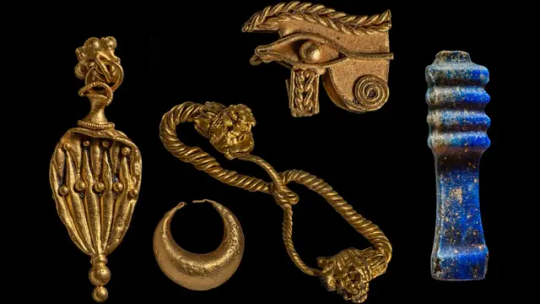
Sunken Temples of Aphrodite and Amun Found off Egyptian Coast
New discoveries off Egyptian coast reveal ‘treasures and secrets
New “treasures and secrets” have been revealed at the site of a sunken temple off Egypt’s Mediterranean coast, the European Institute for Underwater Archaeology (IEASM) announced in a news release Tuesday.
An underwater archaeological team, led by French marine archaeologist Franck Goddio, has made further discoveries at the site of a temple to god Amun in the ancient port city of Thonis-Heracleion in the Bay of Aboukir, the institute said.
The team investigated the city’s south canal, where huge blocks of stone from the ancient temple collapsed “during a cataclysmic event dated to the mid-second century BC,” the institute said.
The temple to god Amun was where pharaohs came “to receive the titles of their power as universal kings from the supreme god of the ancient Egyptian pantheon,” it said.

“Precious objects belonging to the temple treasury have been unearthed, such as silver ritual instruments, gold jewelry and fragile alabaster containers for perfumes or unguents,” IEASM said. “They bear witness to the wealth of this sanctuary and the piety of the former inhabitants of the port city.”
The archaeological excavations, conducted jointly by Goddio’s team and the Department of Underwater Archaeology of the Ministry of Tourism and Antiquities of Egypt, revealed underground structures “supported by very well-preserved wooden posts and beams dating from the 5th century BC,” the institute said.
“It is extremely moving to discover such delicate objects, which survived intact despite the violence and magnitude of the cataclysm,” said Goddio, who is president of IEASM and director of excavations.
The discoveries were made possible thanks to the development and use of new geophysical prospecting technologies that can detect cavities and objects “buried under layers of clay several meters thick,” the institute said.

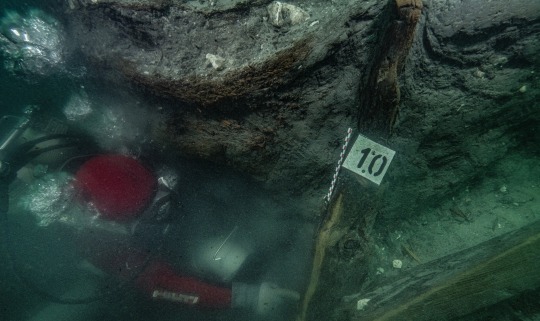
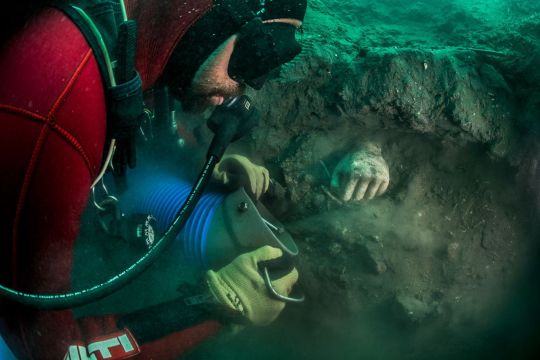
Relics from Greek presence, too
East of the Amun temple, a Greek sanctuary devoted to Aphrodite was discovered containing bronze and ceramic objects.
“This illustrates that Greeks who were allowed to trade and settle in the city during the time of the Pharaohs of the Saïte dynasty (664 - 525 BC) had their sanctuaries to their own gods,” the institute said.
The discoveries of Greek weapons also reveal the presence of Greek mercenaries in the area, IEASM said. “They were defending the access to the Kingdom at the mouth of the Canopic Branch of the Nile. This branch was the largest and the best navigable one in antiquity.”
The remains of Thonis-Heracleion are now located under the sea, 7 kilometers (4.3 miles) from the present coast of Egypt, IEASM said. The city was for centuries Egypt’s largest port on the Mediterranean before the founding of Alexandria by Alexander the Great in 331 BC.
“Rising sea levels and earthquakes followed by tidal waves triggering land liquefaction events, caused a 110 square kilometer portion of the Nile delta to totally disappear under the sea, taking with it the city of Thonis-Heracleion,” the institute said.
The city was discovered by the IEASM in 2000.
By Radina Gigova.
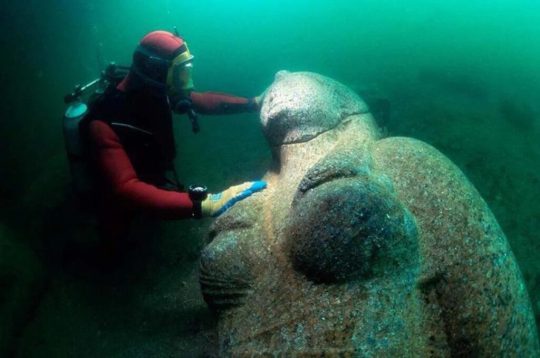
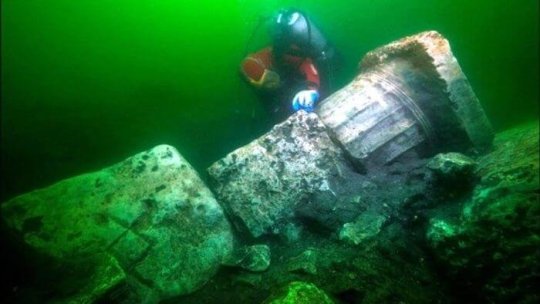
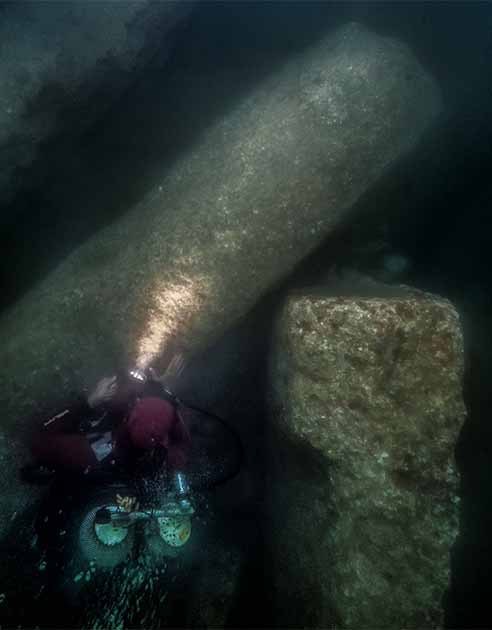
#Sunken Temples of Aphrodite and Amun Found off Egyptian Coast#Thonis-Heracleion#Bay of Aboukir#gold#gold treasure#ancient artifacts#archeology#archeolgst#history#history news#ancient history#ancient culture#ancient civilizations#ancient egypt#egyptian history#egyptian mythology#greek history
278 notes
·
View notes
Note
Hey blue, could you tell me about whale sharks? :]
-LT
WHALE SHARKKSSSSSSS
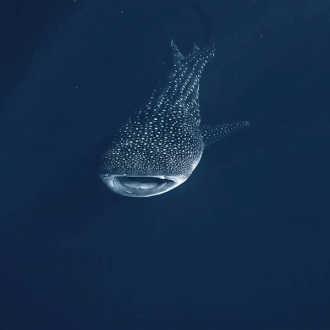
Whale sharks (scientific name Rhincodon Typus) are the largest fish in the sea (specifically females)! The longest whale shark recorded is 61.5 feet long, and the heaviest about 47,000 pounds, or 23.5 tons! Their mouths can be around 4-5 feet wide. They also have the thickest skin of any animal, with various sources estimating it to be anywhere between 4-11 inches thick! Their spot patterns are unique like fingerprints and can be used for identification.
Whale sharks are gentle, slow swimming (up to 3 mph) filter feeders that swim around, open their mouth, suction in water like a vacuum, and eat the little organisms that end up inside! These include plankton, krill, and squid! They have tiny little teeth on the inside of their mouth so when the water floods in, the organisms are trapped in the mouth, and then the water goes back out their gills. They have very small throats so they can only eat small organisms, and as such, they pose no threat to humans.
Like many types of sharks, whale sharks are covered in teeth-like scales called dermal denticles that reduce drag while swimming. However, unlike most sharks, whale sharks have these denticles ON THEIR EYES! It is thought to be that this is a method of protecting the eye, and whale sharks can also retract their eyes between 1/2 inch and 1 inch into their skulls to protect them.
Another fun fact is that no one has ever seen a whale shark give birth!! However, it is known that whale sharks are ovivipariois, meaning the pups (baby whale sharks) hatch from eggs while still inside the mother and then the mother gives birth to live young. A pregnant whale shark was caught and the number of embryos inside her were counted at around 300, so it’s estimated they give birth to about 300 pups at a time. Unfortunately, whale shark pups do have predators including other shark species and orcas, even though adult whale sharks are mainly only threatened by humans, and the survival rate of a whale shark pup to adulthood about one in ten.
Human threat is of high concern to whale sharks, as they are an endangered species. Habitat loss due to overfishing and pollution, illegal poaching and selling of whale shark fins, oil, and meat, entanglement in nets and other debris, boat strikes, and unsustainable tourism all pose threats to these remarkable creatures. However, sustainable ecotourism provides a valuable incentive to keep these animals thriving and their environments intact.
Whale sharks are highly migratory animals that prefer deep trenches of water next to a shallower shelf, as nutrients rise into the shallow water and then they can dive to feed on plankton, krill, squid, etc before coming up to warm back up in the shallow area. Prime coastal feeding spots (at certain times in the season) include Ningaloo Reef in Australia, Cancun, Isla Mujeres, and Isla Holbox in Mexico, Mafia Island in Tanzania, Utila in Honduras, Donsol Bay in the Philippines, the Galápagos Islands, Tofo Beach in Mozambique, and the South Ari Atoll in the Maldives.
For many of these places, ecotourism involving whale shark snorkeling excursions has boosted the area’s economy while providing a powerful incentive for the natural environment to be preserved. However, overcrowding can prove a danger to these beautiful fish, so an ethical whale shark snorkeling trip must: forbid “chumming the waters” or feeding the whale sharks to attract them, limit the number of tourists and boats in the area at a time, only allow snorkeling so the whale shark can safely and quickly swim out of a tourists’ reach if frightened or distressed, and prohibit tourists from touching the whale sharks because touching a whale shark can disrupt the delicate mucous membranes over their skin that help protect them from parasites and bacteria.
I fell in love with whale sharks after seeing them at the Georgia Aquarium in Atlanta, the only aquarium in the West to house whale sharks. These whale sharks came from Taiwan, in the mid/late 2000s, and were transported by a UPS plane in specially built tanks!
Links for if you want to learn more, assist conservation, or just for fun!
World Wildlife Fund: Facts and Conservation (article)
WWF: Adopt a Whale Shark (and receive whale shark stuffie!)
Britannica: Whale Sharks
Georgia Aquarium: Whale Shark Facts (article)
How the Whale Sharks got from Taiwan to Atlanta (video)
One Minute Whale Shark Informational Video
Watch a livestream of the whale sharks at the Georgia Aquarium!!
One of my whale shark stuffies
Yellow lab kisses a whale shark (my favorite video on the Internet)
Whale Shark Octonauts (it’s literally so cute) and creature report song. (both videos)
38 notes
·
View notes
Text
While people are complaining about F1 “tiring” the drivers out by “forcing” them to stand on stage for an hour at 8 PM EST, throw hats and say their government names, please know that there are actually real issues surrounding the Miami Grand Prix that don’t have to do with the fake marina or the inconsequential beach area lol?
Here is a good thread on the racism embedded in the Miami GP. They originally wanted to hold it along Biscayne Bay but that was immediately axed by the rich (white) citizens as it would be held on public property. Instead, it was moved to Miami Gardens without the consent of the neighborhood as it is private property and one of the organizers of the GP also owns Hard Rock Stadium. As the thread says, most of the tourism money being made from the GP will not go to the black people whose community is being upended for the weekend but rather towards richer, whiter areas like South Beach, Brickell, Downtown, etc.
376 notes
·
View notes
Text
random late night thoughts on my famous jimmy junior concept (specifically w/ tinimmy)
jimmy jr moved away in his sophmore year of high school because his mom got him accepted into a really good and well respected performing arts school in california. mom moved to california to live with him while he auditioned and studied and dad stayed behind with andy and ollie (they both missed their mom and jimmy jr SOO MUCH but they'd get to visit during the summer and spring/winter breaks)
tina and jimmy jr continued on again off again dating thru 8th 9th and 10th grades but they were always friends so tina took it super hard when jimmy jr moved away </3 she dated a few guys after him but honestly despite being a hopeless romantic she never felt much of a spark. i think she just missed him too much & never got over her first love. she vowed off dating until after high school
she definitely cried everyday for WEEKS when he actually moved away and stopped hanging out with her friend group w/ tammy and jocelyn. she still kept in contact with zeke but he had a pretty busy life at that point too yknow how it is
jimmy jr would call and text with tina and their friend group sometimes but he got really busy w/ school and life so they eventually fell out of contact. the type of middle school friend you only keep up with through their occasional facebook status updates
jimmy jr got his big break and became a famous teenage heartthrob type when he was around 17 years old and he did NOOOT take it well at all lol he got a huge ego and made so many terrible decisions <3 bless his heart <3 maybe he even thought he was too good for seymour's bay or his friends back home even though i think secretly he missed them. basically stopped talking to his family around this time. super weird for everybody who knew him in seymour's bay that he was now famous and totally idolized but he became something of a local legend to their town like "the birthplace of jimmy pesto jr omg" which was probably good for tourism
jimmy pesto's also got more randos visiting his restaurant because they wanted to see where jimmy jr grew up and harass his family basically lmao which jimmy pesto HATED especially since he became estranged from jimmy jr
it probably settled down after a few years when everybody realized jimmy pesto doesnt talk to his son and also he's an asshole
tina was always very proud of jimmy jr even as his friend because she knew how important dancing and attention/fame had always been to jimmy jr and his passion for it (she'd known him since kindergarten obviously!!!!) so she was always cheering him on like yay ^_^ she might attend an event he was doing locally but ngl he did stay clear of seymour's bay feeling like he had unfinished business there he didnt want to think about. tina was genuinely just happy for him & mostly over her feelings for him
she DID buy all his merch even the cheesy shirtless posters that were definitely made for 12 year old girls to kiss at night. she's LOYAL OKAY!!!!!!
because jimmy jr never came around to seymour's bay and avoided the area he kind of got a reputation with the locals that he thought he was "too good to acknowledge where he came from" so their opinion of him is slightly negative tbh. which isnt UNTRUE but it was less about the town himself and more about the people he left behind
jimmy jr found it really hard to make genuine friendships at his new school bcuz everybody was always trying to compete with each other and eventually he just stopped trying so he's been very socially isolated for a long time which DIDNT help his mental health. he never had another close friend like tina or zeke it was mostly just random party buddies and one night stands but nobody he could be himself around :(
jimmy pesto's relationship with jimmy jr in this fic is much too complicated to describe in a tumblr post lol but its very. uhh. they both want the best for each other and jimmy pesto truly isn't a horrible dad. andy and ollie adore their big brother though and they'll always ask him about his fancy life in hollywood when they go to visit
when jimmy jr first became famous there was some slight attention from younger fans directed @ andy and ollie who were like ooooh they're like jimmy jr but our age and single/not famous?? boyfriend maybe? a few stalkers but that pretty much died immediately when they realized andy and ollie are actual literal Freaks <- they never realized this is also true of jimmy jr though!!!!
he is bisexual. he never told anybody he's bisexual and nobody knows he's bisexual but he is bisexual of course. there is no universe where that kid is straight sorry
#much to say about their relationship but im saving it for maybe someday if i ever write this fic.....#also jimmy pesto and jimmy jr are a whole ass mess in this fanfic especially but there's good intentions?? somewhere deep down?#until he moves back to seymour's bay andy and ollie are like legit the only good thing this kid has in his life so he BETTER cherish them#like goddamn they put up w/ so much of his bullshit. for basically their whole lives#but they love him#bob's burgers#txt
10 notes
·
View notes
Text
SEEN WEDNESDAY ON FREE HAWAI`I TV

This Is How Tourists Are Destroying Coral reefs In Hawai`i
ABC News - January 9, 2023
The millions of tourists who flock to the shores of Hawaii every year are wreaking havoc on its natural environment -- especially the coral reefs, which are at risk all over the world, a new study said.
The most popular coral reefs on the Hawaiian islands are likely being degraded by the very visitors they attract, according to a study published Monday in Nature Sustainability.
Researchers from Princeton University combed through more than 250,000 geotagged Instagram posts from 2018 to 2021 by tourists visiting Hawaiian reefs and compared them with flyover maps of live coral cover. They then used artificial intelligence to analyze reef map images at about a 2-meter resolution, or about 6.5 feet, and 16-meter, or 52.5-feet, depth, according to the study.
Bing Lin, a PhD candidate in science, technology and environmental policy at Princeton University's School of Public and International Affairs and the lead author of the study, got the idea to use social media for the research after doing fieldwork in Hawaii in 2021 and realizing that one of the first things people do when they visit a site is to take a photo and post it to Instagram, he told ABC News.
"They take pictures of the beaches, and they post on social media," he said. "Instagram is by far the main platform through which social media presence is documented, and so I came up with the idea of using Instagram to get a sense of a large-scale representation of where people are distributed in Hawaii."
The scientists found that the accessible sites with more live coral cover were visited more often, but that at the popular sites, coral covers were more degraded compared to those at less popular sites, the paper states.
"We were able to find that coral reefs not only played a really significant role in attracting tourism, but also that the tourism subsequently seemed to suppress live coral coverage at the sites in which tourism was most concentrated," Lin said.
While tourism is mostly concentrated on the shoreline, with lots of activity on the beach, many tourists end up on excursions in which they venture further into the ocean for snorkeling or scuba diving, Lin said.
Using keywords included in captions and hashtags, such as "#scubadiving," Lin was also able to determine a certain degree of interaction with the reefs. Corals tended to thrive farther out into the water, where there are less people, Lin said.
The degradation can happen in the form of diver contact, when divers intentionally or accidentally come in contact with the reefs, as well as elevated pollution in areas that tourists frequent, Lin said.
Places in Oahu in Honolulu County, such as Waikiki Beach, Waimea Bay, Lanikai Beach and Shark's Cove, were among the biggest spots for degraded reefs, Lin said.
Areas on the Big Island were also among the sites with the most degraded coral, he added.
Coral reefs are vulnerable all over the world due to ocean water warming and pollution.
A study published in the Proceedings of the National Academy of Sciences in 2021 found that coral reefs could stop growing in 10 years unless greenhouse gases are significantly reduced.
Coral bleaching, a process that occurs when water is too warm and the algae the corals expel from their tissues cause them to turn completely white, is inundating reefs all over the world, including the Great Barrier Reef in Australia.
In addition to their biodiversity and beauty, coral reefs serve as vital ecosystems, nurture fisheries and protect coasts....
"...The impacts of tourism is detectable across hundreds of sites," Lin said.
89 notes
·
View notes
Text




Oasis Springs invited several different towns to their once-dying town to highlight the changes they'd made and open a discussion about what could be done to help other municipalities facing similar problems. Colleen jumped at the opportunity to outshine her rival, Izumi Ota, and to see some of the country. Oasis Springs was located in the Simerican southwest and Colleen was eager to expand her horizons. Colleen very much enjoyed touring the original town, which had been deemed a historic place and turned into a large walking-only area. Traffic was only allowed in during certain times and it greatly improved the cleanliness of the area.
They also toured an early 20th-century general store with an abandoned garage next door. The town had petitioned to tear the buildings down but the neighborhood it was located in was fighting the petition. The visit also included a stop at a local community pool that had been donated by a developer who built a small subdivision just outside of the main thoroughfare. Colleen had asked many questions about that - Could something like this be worked out in Tinefell Bay? A small Bed & Breakfast was next. The town was encouraging small businesses to open up in town as a way to help keep the momentum going. They were putting a lot of effort into their tourism outreach.
The tour then moved onto the hilltop overlooking the whole town, Snob Hill as the locals called it. It was a large shopping district with mixed-use space on the floors above the retail level. Construction was just wrapping up and the town was going to hold a large grand opening ceremony next year. Across from that monolith was an upscale movie theater and cafe. The hope was that this would become a destination for the surrounding area to visit, while those who could afford it would live in the apartments above and enjoy breathtaking views of the vistas the desert had to offer.
#Gosnoll Ancestry#ts4 decades challenge#sims4#sims 4#sims 4 screenshots#sims 4 historical#ts4 historical#decades challenge#simerican#GA Gen 6#Colleen Gosnoll#GA 1980s
7 notes
·
View notes
Text
Can corals be saved? As record ocean heat threatens corals off Florida and across the globe, conservationists are shifting their strategy. (Washington Post)
With milk crates of corals in hand and scuba tanks strapped to their backs, Sam Burrell and his team disappeared under the water’s choppy surface. Heavy, breaking waves crashed against the charter boat anchored miles off the coast.
With each breath they let out, they descended beneath the surface and felt a sense of relief: On this November morning, they were finally returning hundreds of corals pulled out of the water earlier in the year after one of the hottest marine heat waves on record threatened to wipe them out. For months, the corals sat in temperature-controlled tanks in the shadow of the gulf’s bay until the waters were cool enough for them to go back— and though conditions weren’t ideal, this was that moment.
Groups like Burrell’s had been prepared to do whatever it took to save the corals — even if that meant evacuating them each summer. But they now realize they need to radically shift their approach.
With record ocean temperatures threatening another dire summer, the National Oceanic and Atmospheric Administration and coral restoration groups are shifting their efforts to better keep up with the warming climate. The goal is clear: Find the survivors from last summer’s heat wave and focus on restoring areas where the species will have the best chance when heat strikes again.
How they execute the new plan could mean the difference between saving what’s left on Florida’s 360-mile-long coral reef and another summer of catastrophic loss. Already, some coral experts have questioned how far humans will go to keep corals alive in an environment that struggles to sustain them. At risk is the very future of these corals, a species that serves as an underwater city to more than 7,000 other marine plants and animals, survived prehistoric mass extinctions and outlived the dinosaurs. The collapseof coral in the Keys would also have an economic ripple effect: Thousands of people could lose jobs related to a key part of regional tourism.
Corals thrivein water temperatures between 73 and 84 degrees Fahrenheit, according to NOAA. But last summer, shallow-water temperatures in the lower Keys reached a walloping 101 degrees Fahrenheit. Other places simmered in the mid to high 90-degree range.
As bleaching events increase in severity and frequency, it becomes harder for certain corals to bounce back. Last summer, corals in the Keys endured the hottest ocean temperatures on record, according to NOAA’s Mission: Iconic Reefs, a coalition of public and private groups. This heat streak has lasted more than a year: NOAA and the International Coral Reef Initiative just confirmed bleaching-level heat stress in every corner of the ocean.
Robyn Mast, a Key West reef restoration associate at CRF, recalled an emotional scene when she saw the havoc last year’s heat wrought on the species. Entire stretches looked like they were covered in a fresh layer of snow. The corals, full of color just days before, were bleached. As she dove closer, she realized many of the colorful coral left were burned to death: They had died so quickly that they didn’t even have the chance for color to drain. Temperatures were so hot that coral tissue melted from its skeleton.
3 notes
·
View notes
Text



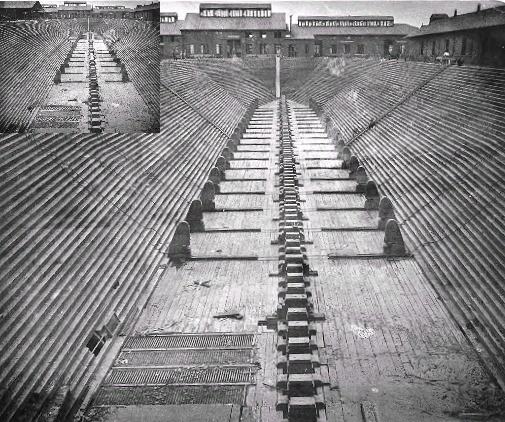
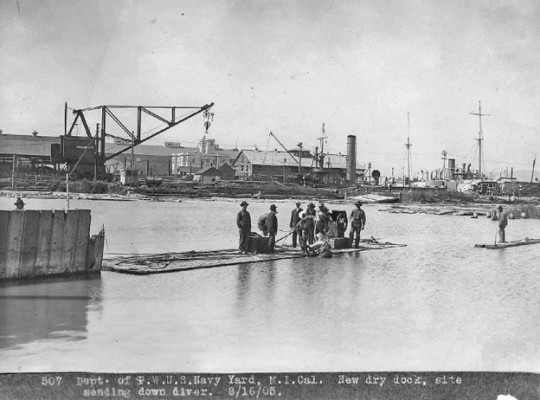
Wooden Dry-Docks?
The USS Emory S. Land (AS-39), a submarine tender, has recently docked a couple of times for overhaul in Mare Island’s dry dock 2. She owed her presence in that dry dock to decisions made a century and a quarter ago. Then, like now, the US Navy was limited by the lack of shoreside infrastructure and specifically, dry docks.
In 1897 Rear Admiral Francis Bunce chaired a board investigating the lack of shore infrastructure. That board recommended a forty percent increase in the number of dry docks at naval shipyards which included a new dry dock 2 at Mare Island Naval Shipyard that was to accommodate the largest naval warship envisioned. To save money, the new Mare Island dry dock was to be constructed of timber rather than stone or concrete. Believe it or not timber dry docks were considered by some to be just as durable as a stone dock (Mare Island’s first floating drydock was constructed of wood and lasted nearly 40 years before it was completely worn out and scrapped). The dock was so long that it had to be angled in from the waterfront to fit without impacting existing facilities. Following debate, the new dry dock was authorized and funded by Congress, but the Navy Bureau of Yard and Docks was not happy with the proposed timber construction. Experience had taught them that timber graving docks deteriorated in 20-25 years and were subject to catastrophic flooding.
As a result, the Secretary of the Navy became engaged to obtain additional funds to allow the proposed timber dock at Mare Island to be changed to concrete. In late 1899 the Board of Trade of San Francisco and the San Francisco Chamber of Commerce adopted resolutions asking the California delegation, in Congress to aid the Secretary of the Navy and the Chief of the Navy Bureau of Yard and Docks in their efforts to have the construction material changed. The effort was successful, and a concrete dry dock was constructed. The new dry dock was the largest dry dock at any naval shipyard at that time. The decision to use concrete was to prove wise as the new dry dock was to serve the Navy through two world wars, the Korean, Vietnam, and Cold Wars. The dry dock continues in use to this day by the private Mare Island Dry Dock LLC. It is hard to say what would have happened if the dry dock had been built of timber as originally proposed, but certainly the dock would not have been available during our Nation’s greatest hour of need during World War II.
#mare island#naval history#san francisco bay#us navy#vallejo#Bay Area#San Francisco#California#shipyard#Solano#Sonoma#Napa#Wine Country#Military#Tourism#Old Navy
0 notes
Note
Is there anything you’d recommend in north Wales? I never really leave Scotland so I’ve no idea about it.
visit Llandudno, it's the tourism hub of north wales for a reason. there's the mines that offer tours, the alice in wonderland hunt, the trams and the cable cars, two different beaches, a pier with an arcade, an artificial ski slope, a lot of good shops, the great orme and little orme. if you've got your own transport i highly recommend visiting snowdonia national park and camping at the base of Snowdon in the summer.
conwy is also a lovely place, it's a seaside town built around its castle and has the uk's smallest house. i dont go there nearly half as much as I've been to Llandudno, mostly because its a pain to go on the buses. colwyn bay is a bit less pristine than the other two but the beach and prom are really nice and the shopping centre is decent with a market (dont expect much) every tuesday and Saturday. the beach in bae colwyn is sandy because a decade back they dredged it up from the ocean floor.
just whatever you do, do not go to rhyl. complete shithole. one of the uks lowest life expectancies. id cut off my own leg before foinf there willingly. I'm from the conwy county area (god forbid i doxx myself) so im biased towards it with tbe exception of rhyl. llanddulas doesn't have much to do in it (its an old people neighborhood, i lived there for 5 years and stayed inside the whole time), abergele has it's own beach + arcade area but you're better off going to Llandudno for a lot of things.
4 notes
·
View notes
Photo




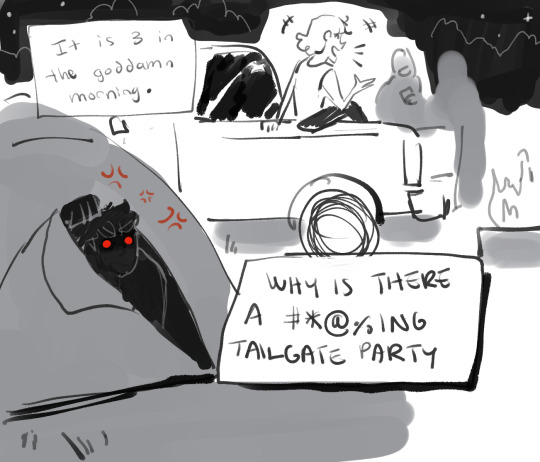
more late night trip inspired comics as i reflect and try to distract myself from the rain warning
we didn’t stop in Calgary but we did get caught in its Traffic Vortex of Influence which is always fun because, as the stereotype goes, Calgarians are intent on passing each other in the drive through lane. (It’s not that Ed’s not a bad driver in his own right it’s just he’s in Vacation Mode ok) (and I just think Calvin is way more prone to road rage)
Okotoks was nice but it made me feel a bit unsettled by how clean and touristy it was, it specifically made me think of it as the Alberta version of Oak Bay, haha. Dedicated to tourists (or visiting day trippers from Calgary with deep pockets) and tourist towns always make me feel unsettled because our solution to tourism in Edmonton is locking all the tourists in the Mall and not otherwise encouraging them, haha. (also, an ongoing trope in southern alberta was the Wideness of the streets and sidewalks. what do you mean your towns were built around horses and railways and not french style river lots.....)
the one night we stayed in Okotoks was probably the worst - we’d had a lovely evening and a nice long walk but we returned to the campground only to be kept up all night by a group of Calgary-area folks who were smoking and drinking and laughing and yelling and playing music into the wee hours, literally RIGHT next to us, even though we told them to stop. Twice. and worst of all, they didn’t even clean up all the cans and just left all their trash on the table all night and all morning. Anyways, I don’t think Calvin is one to tolerate smoking too close to him but I do have a sense he is the sort of person to stay up late chatting, especially if it’s in the back of a truck...
#projectcanada cities#pc: calgary#pc: edmonton#calvin mccall#edward murphy#boab omake#hapo travels#truly a number of things in okotoks#quatsch and i would literally whisper how much we wanted their blood all night#and when they asked if they were loud she straight up told them she was vividly imagning murdering them or something to that effect#they DID NOT CARE#anyway she reported them before we left since they were staying longer so#hope whoever got stuck with them had a good sleep
19 notes
·
View notes
Text
Discover the Enchantment of Hurghada: A Jewel by the Red Sea
Nestled on the stunning coast of the Red Sea, Hurghada is a paradise that beckons travelers with its turquoise waters, vibrant coral reefs, and an array of unforgettable experiences. A perfect blend of relaxation and adventure, this Egyptian city has evolved from a serene fishing village into a bustling hub of tourism, offering a myriad of activities for every type of traveler. Let's dive into what makes Hurghada a must-visit destination for your next vacation.
Unparalleled Diving and Snorkeling Adventures
Hurghada is a haven for underwater enthusiasts. Home to some of the world's most exquisite coral reefs and marine life, the city is a hotspot for diving and snorkeling. Whether you're a seasoned diver or a beginner, the crystal-clear waters of the Red Sea provide the perfect backdrop for exploring vibrant coral gardens and enchanting underwater landscapes. Popular sites like the Giftun Islands and Abu Ramada Island offer mesmerizing views of colorful fish, turtles, and even dolphins, making every dive a unique experience.
Luxurious Beach Resorts and Waterfront Relaxation
For those seeking relaxation, Hurghada's luxury resorts offer world-class amenities with breathtaking sea views. From private sandy beaches to infinity pools, spa treatments, and gourmet dining, visitors can indulge in unparalleled comfort and serenity. Resorts in areas like Sahl Hasheesh and Makadi Bay are renowned for their exquisite services, providing an oasis of tranquility away from the bustling city life.
Thrilling Desert Safaris and Cultural Tours
Adventure enthusiasts will find no shortage of excitement in Hurghada. The city's surrounding desert is a playground for thrilling activities such as quad biking, camel riding, and Jeep safaris. Exploring the vast desert landscape, with its majestic mountains and bedouin villages, offers a glimpse into the heart of Egypt's natural beauty and ancient culture. For a deeper dive into history, day trips to the iconic cities of Luxor and Cairo reveal the wonders of ancient Egypt, from the Valley of the Kings to the Great Pyramids.
A Culinary Journey Through Egyptian Delicacies
Hurghada's dining scene is as diverse as its landscapes. Visitors can savor traditional Egyptian dishes, fresh seafood, and international cuisine at various restaurants and cafes. The marina and downtown areas are bustling with culinary hotspots where you can enjoy mouthwatering koshari, succulent grilled seafood, and rich Arabic coffee. Dining by the waterfront, with views of the Red Sea, adds a magical touch to every meal.
Vibrant Nightlife and Entertainment
As the sun sets, Hurghada transforms into a vibrant nightlife hub. The city's bars, clubs, and beach parties come alive with music, dance, and entertainment. From laid-back beach bars to electrifying nightclubs featuring international DJs, there's something for everyone to enjoy. The Marina Boulevard is a popular spot for evening strolls, shopping, and experiencing the lively local atmosphere.
Eco-Tourism and Conservation Efforts
In recent years, Hurghada has embraced eco-tourism, with initiatives aimed at preserving its natural wonders and promoting sustainable tourism practices. Visitors can participate in coral reef conservation projects, eco-friendly diving expeditions, and educational tours that highlight the importance of environmental preservation.
Plan Your Visit to Hurghada
Whether you're an adventure seeker, a history enthusiast, or simply in need of a peaceful getaway, Hurghada offers a slice of paradise with something for every traveler. With its stunning landscapes, rich culture, and vibrant atmosphere, Hurghada promises an unforgettable vacation experience by the Red Sea. Start planning your journey to this Egyptian treasure and discover the magic of Hurghada for yourself.
#Red Sea#Diving#Snorkeling#Luxury resorts#Coral reefs#Marine life#Giftun Islands#Abu Ramada Island#Sahl Hasheesh#Makadi Bay#Quad biking#Camel riding#Jeep safaris#Desert Safaris#Cultural Tours#Egyptian Delicacies#Fresh seafood#Nightlife#Eco-Tourism#Conservation Efforts#Sustainable Tourism#Marina Boulevard#Vibrant Nightlife#Adventure
2 notes
·
View notes
Text
As the sea rises and the population booms, builders around the world are in a race to transform coastal bays and shallow seas into new land. Yet don’t mistake this rush of land reclamation as a response to the challenges we face. “It’s built for rich people,” explains Dhritiraj Sengupta, a physical geographer at England’s University of Southampton. Sengupta’s latest research shows there’s been a huge increase in the use of reclaimed land for luxury hotels, shopping areas, and high-end living spaces—developments designed to boost a city’s global reputation.
Dubai, in the United Arab Emirates, is a good example of this prestige building, Sengupta says. Tourism and economic development—especially to lure a wealthy clientele—has driven most of the building boom in Dubai. But it also highlights the issues with reclaimed land. The World in Dubai, a world map–shaped artificial archipelago and one of the largest examples of luxury reclamation, covers around 50 square kilometers. But development on the islands has stalled, and there are claims it’s already washing away.
Land reclamation—dumping sand, rocks, and other materials along coastal areas and building structures like sea walls to keep it all in place—is not new. Many metropolises, like New York City in New York and Mumbai in India, are built on reclaimed land, as are large swaths of some countries, like the Netherlands. But what is striking about recent land reclamation, Sengupta says, is the pace. “Cities are growing rapidly,” he says.
Using satellite imagery to analyze the growth of 135 coastal cities with at least one million residents between 2000 and 2020, Sengupta found that 106 cities have expanded into the sea. In total, these 106 cities have added more than 2,530 square kilometers of land—an area the size of Luxembourg. Asia is leading this land grab, accounting for 98 percent of the growth.
Shanghai, China, alone has reclaimed 350 square kilometers of land, while Colombo, Sri Lanka, built 100 square kilometers in just four years. Elsewhere, cities in South Korea, United Arab Emirates, Saudi Arabia, and Singapore all added at least 30 square kilometers to their coasts over the past two decades.
But when Sengupta compared his analysis with data from the Intergovernmental Panel on Climate Change, he found that more than 70 percent of this new land will likely be underwater by 2100.
11 notes
·
View notes